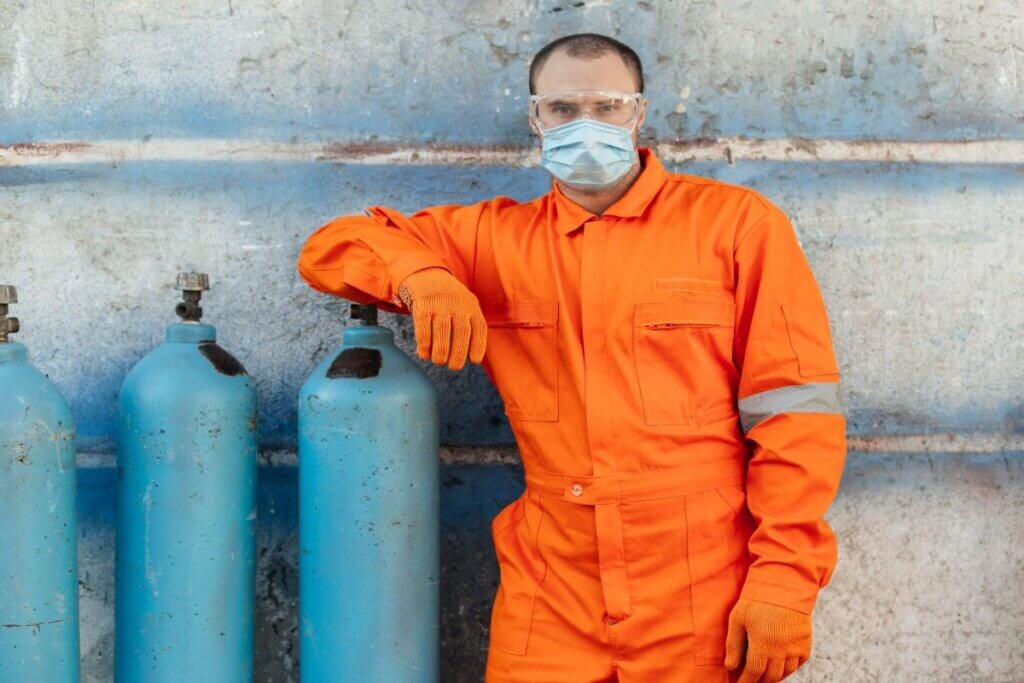Hydrogen peroxide is one of those bottles you’ll find almost anywhere, under the bathroom sink, in a janitor’s closet, or in a laboratory cabinet.
People know it as that fizzing liquid that foams up on a scrape, but beyond first aid, it has a long list of uses.
With all that exposure, one big question keeps coming up: Is hydrogen peroxide flammable?
The answer is no, but that doesn’t mean it’s free of fire risk. Its real danger lies in how it behaves around other materials, especially at higher concentrations.
Why People Associate It with Fire
Hydrogen peroxide looks like water, yet it acts very differently. When you pour it on a cut, the bubbling is oxygen being released as it breaks down.
That oxygen is why people assume it catches fire. The truth is, hydrogen peroxide itself doesn’t ignite like gasoline or rubbing alcohol. Instead, it feeds existing flames.
Think of it this way: fire needs oxygen to grow. Hydrogen peroxide releases oxygen when it decomposes, and that extra oxygen makes anything nearby burn hotter and faster.
So while it’s not flammable by definition, it makes fires much more aggressive if one starts close to it.
A Bit of Chemistry in Plain Language
On paper, hydrogen peroxide is H₂O₂- two hydrogen atoms bonded to two oxygen atoms. Compared to water (H₂O), it has that extra oxygen, and that’s what makes it unstable. Heat, light, or contact with metals like iron can cause it to break apart into water and oxygen gas.
Sometimes that breakdown is slow, like the way a brown bottle of peroxide slowly loses its fizz over months. Other times it’s violent, especially when the liquid is concentrated. That instability is why hydrogen peroxide is mild enough to clean a cut at 3% but strong enough to act as a propellant in rockets when highly concentrated.
Household Peroxide vs. Industrial Strength
The bottle you pick up at a pharmacy is usually 3%. At that strength, it stings a bit, whitens fabric, and loses potency if you leave it in the sun. Harmless enough if handled with care.
But step up the concentration and the risks rise sharply:
- 3% hydrogen peroxide(household): Used for wound cleaning and light cleaning around the home.
- 6% hydrogen peroxide (beauty care): Common in hair bleach and some teeth whitening products. Stronger, but still manageable.
- 35% hydrogen peroxide (industrial/food processing): Used for disinfecting equipment and bleaching textiles. Corrosive to skin and eyes.
- 70% hydrogen peroxide (aerospace, propulsion): Specialized use only. At this level, hydrogen peroxide is reactive enough to cause fires or explosions if mishandled.
That’s why concentration matters so much. The higher the percentage, the more oxygen it can release, and the more dangerous it becomes if spilled or contaminated.
Storage Rules That Make All the Difference
Peroxide needs to be stored carefully. Brown bottles aren’t a design choice; they block light that would speed up their breakdown. Even with protection, hydrogen peroxide gradually decomposes, which is why caps sometimes hiss when you open a bottle.
Industrial facilities deal with bigger challenges. A container left in direct sunlight or contaminated with bits of metal can overheat, decompose rapidly, and even rupture.
There have been warehouse accidents where spilled peroxide caused nearby organic materials, like wood or cloth, to catch fire without a flame. It’s another reminder that while it isn’t flammable in itself, it creates the conditions that make fires more likely.
From Medicine Cabinets to Rocket Engines
Hydrogen peroxide has an unusual history. In medicine, it’s been used since the 1800s as a disinfectant. Generations have poured it on scrapes, and while its effectiveness on wounds is debated, its role in cleaning and sterilization is well established.
In the 20th century, militaries and engineers discovered another side of it. Concentrated peroxide could power torpedoes, submarines, and rockets. When it decomposes quickly, it releases hot gases and large amounts of oxygen – perfect for propulsion. Few chemicals span such a range: antiseptic in one setting, rocket fuel in another.
Accidents, Misuse, and Misunderstandings
Most peroxide-related injuries come from people underestimating concentrated solutions. Some assume “food-grade” peroxide is safe to ingest because of the label. In reality, swallowing even a small amount of 35% peroxide can burn the throat and stomach or cause dangerous bubbles in the bloodstream.

In workplaces, spills of concentrated peroxide on organic materials like rags or paper have caused fires to start on their own. These cases blur the line between “flammable” and “oxidizer,” which is why so many people stay confused about its true behavior.
Why the Confusion Lingers
Part of the problem is language. Safety data sheets describe hydrogen peroxide as an “oxidizer,” but most people equate that with being flammable. They’re not the same thing. Flammable liquids ignite; oxidizers make other things ignite more easily.
Still, from a practical point of view, the effect can look similar. If a spill leads to a nearby material smoldering, it feels like the liquid itself caught fire. That’s why the myth sticks around.
Everyday Reminders and Seasonal Habits
Outside labs and factories, hydrogen peroxide shows up in more casual ways. Around Halloween, people use it to bleach hair or disinfect pumpkin-carving tools.
During flu season, sales spike as families use it to disinfect surfaces. These are low-strength solutions, but mixing peroxide with the wrong thing, like vinegar or certain cleaners, can create corrosive byproducts that irritate the lungs.
It’s easy to forget that even a common household chemical has risks if handled carelessly.
Thinking About Fire Science
Every fire needs three ingredients: fuel, heat, and oxygen. Hydrogen peroxide adds the oxygen. On its own, it doesn’t provide the spark or the fuel, but once those exist, peroxide makes the reaction faster and fiercer.
It’s similar to using a bellows on a fire pit. The wood and the match start the fire, but it’s the sudden rush of oxygen that makes the flames leap. Hydrogen peroxide works in much the same way – only in liquid form.
Practical Safety Advice
At home, the basics are straightforward:
- Stick with 3% solutions for first aid or cleaning.
- Keep bottles sealed and out of direct sunlight.
- Never mix it with other cleaning products unless directed.
In workplaces where concentrated peroxide is used, safety ramps up. Workers need protective clothing, face shields, and good ventilation.
Containers must be designed for oxidizers, and storage areas should stay cool and away from organic materials.
Lapses in these precautions have led to serious incidents in the past.
Firefighters and Hazmat Response
First responders treat concentrated hydrogen peroxide with special caution. A fire near a peroxide spill doesn’t behave like a typical blaze.
The oxygen release can make flames spread quickly or reignite after being put out. Hazmat teams often dilute spills with water, but even that has to be done carefully to avoid sudden reactions.
Pulling the Threads Together
So, is hydrogen peroxide flammable? No. But that simple answer only scratches the surface.
Hydrogen peroxide doesn’t catch fire like gasoline. Instead, it supercharges fires around it by releasing oxygen.
In households, it’s relatively safe at low concentrations. In industrial or aerospace contexts, it’s powerful enough to drive engines or cause accidents if not handled with respect.
Final Thoughts: Treating Hydrogen Peroxide with the Respect It Deserves
Hydrogen peroxide wears many hats: wound cleaner, surface disinfectant, bleaching agent, and even rocket fuel. That wide range of uses explains why it’s so misunderstood. It isn’t flammable in itself, but it absolutely makes other substances burn more fiercely.
Handled properly, it’s safe and reliable. Handled carelessly, it can turn an ordinary spill into something far more dangerous.
Choosing the Right Supplier
For industries that depend on concentrated solutions, having the right supplier matters just as much as having the right safety protocols.
That’s where PureChemPros comes in, providing not just quality products but also the expertise needed to use them responsibly.
With the right partner by your side, every use of hydrogen peroxide becomes safer, smarter, and more effective.Contact us today and let’s build that partnership!

